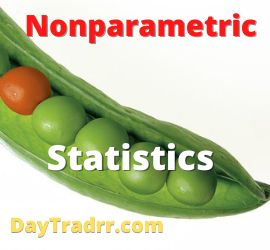What Are Nonparametric Statistics?

Nonparametric statistics is a statistical inference method focusing on rankings rather than numbers or underlying distribution assumptions. With nonparametric statistics, data are not expected to come from specified models determined by a small number of parameters. Examples of such models include the normal distribution model and the linear regression model. Nonparametric statistics may use ordinal data, which means it does not rely on numbers but rather on a ranking or order of sorts. Ordinal data is a type of categorical data that has a fixed order or scale. For example, ordinal data would be the result of a poll when a respondent rates his or her financial satisfaction on a scale of 1 to 10. There is no standard scale on which the difference in each score is measured in ordinal data.
Nonparametric statistics encompass statistical models, inference, and statistical tests. The model structure of nonparametric models is determined by data and theoretical deduction. This is rather than being established based on empirical observation. The word nonparametric does not indicate that such models have no parameters. Rather, the quantity and nature of the parameters are adjustable and not predetermined. A nonparametric estimate of a probability distribution is a histogram. It is a visual representation of numerical data showing the number of data points that fall within a given range of values.
Understanding Nonparametric Statistics
Parametric statistics contain parameters such as the mean, standard deviation, Pearson correlation, variance, and so on. However, the observed data is used to estimate the distribution’s parameters in this type of statistical analysis. Data are frequently assumed to come from a normal distribution with unknown parameters. Population mean and variance are then approximated using the sample mean and sample variance in parametric statistics. Nonparametric statistics make no assumptions about sample size or the nature of the observed data.
Nonparametric statistics do not presume that data follows a normal distribution. Rather, this type of statistical measurement estimates the shape of the distribution. A normal distribution can be assumed in many instances. However, there are some in which the underlying data-producing process is far from normal.
Parametric Data
A sample of data selected from a known data distribution is referred to as parametric data. This suggests that the distribution is known or recognized. Therefore, the distribution conforms to familiar properties. Parametric is frequently used as an abbreviation for real-valued data drawn from a normal or Gaussian distribution. This is a convenient shorthand, but it is not totally correct.
In general, statisticians prefer to deal with parametric data. They will even go so far as to apply data preparation procedures that make data parametric. For example, using data transforms in order to utilize well-known statistical approaches. Analysts and researchers can apply parametric procedures if they have parametric data from the start. There is a whole array of statistical methods designed for data with a Gaussian distribution if parametric data is available.
- Summary statistics.
- Correlation between variables.
- Significance tests for comparing means.
Nonparametric Data
Nonparametric data is data that does not fit a known or well-understood distribution. Data may be non-parametric for a variety of reasons:
- Ordinal data – Data that is not real-valued, and does not relate to other values, intervals, or some other form.
- Improper fit – Data that is real-valued but does not fit a well-understood shape.
- Outliers – Data that is almost parametric but contains outliers, multiple peaks, a shift, or some other feature.
Nonparametric statistical methods are a set of approaches that can be used with nonparametric data. In reality, most parametric procedures have a nonparametric counterpart. Nonparametric method findings are generally less powerful than their parametric counterparts. This is largely due to the fact that they must be adapted to function for all sorts of data. They can still use them for inference and to make claims about findings and results. However, they will not be given the same weight as claims made using parametric approaches. Therefore, the distribution information is discarded.
Nonparametric statistics are the only type of statistics that may be applied with ordinal or interval data. These statistical methods are necessary for applied machine learning and for real-valued data. Particularly, when making claims on data that does not fit the typical normal or Gaussian distribution.
Example of Nonparametric Statistics
Consider a financial analyst who wants to calculate the value-at-risk (VaR) of an investment. Earnings data from hundreds of identical investments over a similar time period are gathered by the analyst. Rather than assuming that earnings are distributed normally, he uses a histogram to estimate the distribution nonparametrically. The result is a nonparametric estimate of VaR based on the histogram’s 5th percentile.
Nonparametric Statistics – Advantages
Nonparametric statistics have a broader application than parametric statistics. This is because it makes fewer assumptions about the sample data. However, nonparametric approaches will be less efficient in circumstances where parametric testing is more suited. This is because, unlike parametric statistics, nonparametric statistics reject some information from the data.
Simplicity and ease of use
Because of simplicity and ease of use, nonparametric statistics have gained popularity. The data becomes more applicable to a wider range of tests as the demand for parameters is reduced. Consider when the mean, sample size, standard deviation, or estimation of any other related parameters are not available. In these cases, this sort of statistical method might be employed.
Nonparametric statistics assess the median
This may be preferable in some cases. Nonparametric analyses are advantageous for some datasets because they evaluate the median rather than the mean. The mean is not necessarily the best indication of a sample’s central tendency. Even if it is possible to run a valid parametric analysis on skewed data, that doesn’t mean it’s the better method.
Valid with a small sample size
Nonparametric statistics yield valid conclusions even when the sample size is small and the data is possibly nonnormal. You can use nonparametric analysis even when your sample size is small. Or, you are unsure that your data follows the normal distribution. Be cautious that with small sample sizes, normality tests may lack the capacity to yield useful results. This is a challenging scenario. Nonparametric analyses have reduced power from the start compared to parametric analyses. Therefore, small sample size can make the problem worse.
Nonparametric methods can analyze ordinal data, ranked data, and outliers
Outliers might skew the results of parametric tests because they can only assess continuous data. Nonparametric tests, on the other hand, may assess ordinal and ranked data without being thrown off by outliers. Outliers can be properly removed from a dataset if they indicate exceptional conditions. However, outliers are occasionally a true element of the distribution for a research region and should not be removed. Different statistical methods can analyze different types of data and handle outliers differently. Therefore, you should double-check the assumptions for nonparametric analysis.
Up Next: What Is Absorption Costing?
 Absorption costing is an accounting method and reporting standard that tracks and allocates expenses associated with a manufacturing process to distinct products. It is sometimes called full costing. As an accounting method, it captures all fixed and variable costs associated with manufacturing a particular product. The direct and indirect costs, such as direct materials, direct labor, rent, and insurance, are accounted for by using this method. Generally accepted accounting principles (GAAP) require that absorption costing be used for all external reporting.
Absorption costing is an accounting method and reporting standard that tracks and allocates expenses associated with a manufacturing process to distinct products. It is sometimes called full costing. As an accounting method, it captures all fixed and variable costs associated with manufacturing a particular product. The direct and indirect costs, such as direct materials, direct labor, rent, and insurance, are accounted for by using this method. Generally accepted accounting principles (GAAP) require that absorption costing be used for all external reporting.
Absorption costing tracks and allocates the expenses associated with a manufacturing process to distinct products. Accounting standards call for this form of cost accounting in order to generate an inventory valuation for an organization’s balance sheet. A product can absorb both fixed and variable costs. When a company pays these expenses, they are not necessarily recorded in the month in which they are incurred. Instead, they are held as an asset in inventory until the inventory is sold. At this point, they are charged against the cost of goods sold.




